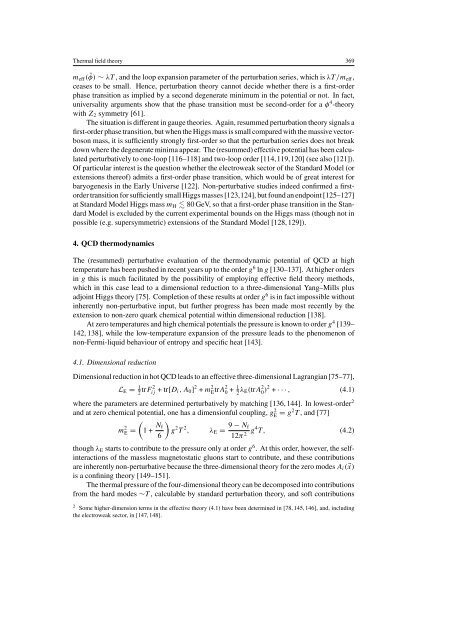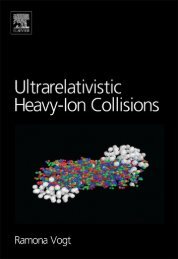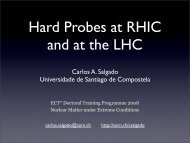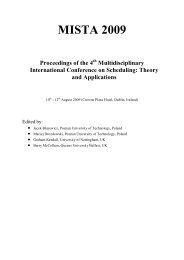Advances in perturbative thermal field theory - Ultra-relativistic ...
Advances in perturbative thermal field theory - Ultra-relativistic ...
Advances in perturbative thermal field theory - Ultra-relativistic ...
You also want an ePaper? Increase the reach of your titles
YUMPU automatically turns print PDFs into web optimized ePapers that Google loves.
Thermal <strong>field</strong> <strong>theory</strong> 369<br />
m eff ( ¯φ) ∼ λT , and the loop expansion parameter of the perturbation series, which is λT /m eff ,<br />
ceases to be small. Hence, perturbation <strong>theory</strong> cannot decide whether there is a first-order<br />
phase transition as implied by a second degenerate m<strong>in</strong>imum <strong>in</strong> the potential or not. In fact,<br />
universality arguments show that the phase transition must be second-order for a φ 4 -<strong>theory</strong><br />
with Z 2 symmetry [61].<br />
The situation is different <strong>in</strong> gauge theories. Aga<strong>in</strong>, resummed perturbation <strong>theory</strong> signals a<br />
first-order phase transition, but when the Higgs mass is small compared with the massive vectorboson<br />
mass, it is sufficiently strongly first-order so that the perturbation series does not break<br />
down where the degenerate m<strong>in</strong>ima appear. The (resummed) effective potential has been calculated<br />
<strong>perturbative</strong>ly to one-loop [116–118] and two-loop order [114,119,120] (see also [121]).<br />
Of particular <strong>in</strong>terest is the question whether the electroweak sector of the Standard Model (or<br />
extensions thereof) admits a first-order phase transition, which would be of great <strong>in</strong>terest for<br />
baryogenesis <strong>in</strong> the Early Universe [122]. Non-<strong>perturbative</strong> studies <strong>in</strong>deed confirmed a firstorder<br />
transition for sufficiently small Higgs masses [123,124], but found an endpo<strong>in</strong>t [125–127]<br />
at Standard Model Higgs mass m H 80 GeV, so that a first-order phase transition <strong>in</strong> the Standard<br />
Model is excluded by the current experimental bounds on the Higgs mass (though not <strong>in</strong><br />
possible (e.g. supersymmetric) extensions of the Standard Model [128, 129]).<br />
4. QCD thermodynamics<br />
The (resummed) <strong>perturbative</strong> evaluation of the thermodynamic potential of QCD at high<br />
temperature has been pushed <strong>in</strong> recent years up to the order g 6 ln g [130–137]. At higher orders<br />
<strong>in</strong> g this is much facilitated by the possibility of employ<strong>in</strong>g effective <strong>field</strong> <strong>theory</strong> methods,<br />
which <strong>in</strong> this case lead to a dimensional reduction to a three-dimensional Yang–Mills plus<br />
adjo<strong>in</strong>t Higgs <strong>theory</strong> [75]. Completion of these results at order g 6 is <strong>in</strong> fact impossible without<br />
<strong>in</strong>herently non-<strong>perturbative</strong> <strong>in</strong>put, but further progress has been made most recently by the<br />
extension to non-zero quark chemical potential with<strong>in</strong> dimensional reduction [138].<br />
At zero temperatures and high chemical potentials the pressure is known to order g 4 [139–<br />
142, 138], while the low-temperature expansion of the pressure leads to the phenomenon of<br />
non-Fermi-liquid behaviour of entropy and specific heat [143].<br />
4.1. Dimensional reduction<br />
Dimensional reduction <strong>in</strong> hot QCD leads to an effective three-dimensional Lagrangian [75–77],<br />
L E = 1 2 trF ij 2 +tr[D i,A 0 ] 2 + m 2 E trA2 0 + 1 2 λ E(trA 2 0 )2 + ···, (4.1)<br />
where the parameters are determ<strong>in</strong>ed <strong>perturbative</strong>ly by match<strong>in</strong>g [136, 144]. In lowest-order 2<br />
and at zero chemical potential, one has a dimensionful coupl<strong>in</strong>g, gE 2 = g2 T , and [77]<br />
(<br />
m 2 E = 1+ N )<br />
f<br />
g 2 T 2 , λ E = 9 − N f<br />
6<br />
12π 2 g4 T, (4.2)<br />
though λ E starts to contribute to the pressure only at order g 6 . At this order, however, the self<strong>in</strong>teractions<br />
of the massless magnetostatic gluons start to contribute, and these contributions<br />
are <strong>in</strong>herently non-<strong>perturbative</strong> because the three-dimensional <strong>theory</strong> for the zero modes A i (⃗x)<br />
is a conf<strong>in</strong><strong>in</strong>g <strong>theory</strong> [149–151].<br />
The <strong>thermal</strong> pressure of the four-dimensional <strong>theory</strong> can be decomposed <strong>in</strong>to contributions<br />
from the hard modes ∼T , calculable by standard perturbation <strong>theory</strong>, and soft contributions<br />
2 Some higher-dimension terms <strong>in</strong> the effective <strong>theory</strong> (4.1) have been determ<strong>in</strong>ed <strong>in</strong> [78, 145, 146], and, <strong>in</strong>clud<strong>in</strong>g<br />
the electroweak sector, <strong>in</strong> [147, 148].







